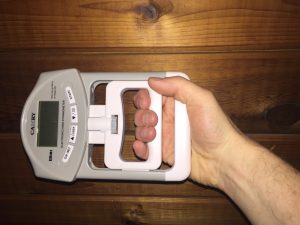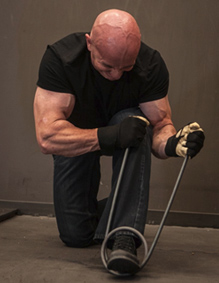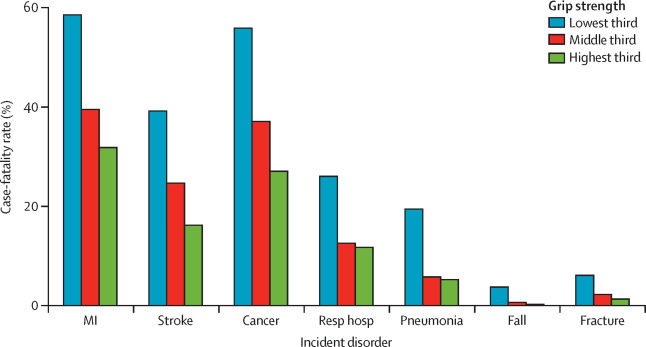For some reason, I’ve been getting questions and finding myself in conversations about grip quite a bit lately.
Now, there’s a lot of misinformation on grip…especially on how firmly you should grip, how to improve grip, and what to do about reduced grip from arthritis, carpal tunnel, and other pain issues.
Take the 100% grip or “Iron grip” as an example.
Grab anything with 100% grip and your hand is going to shake.
Drop off to the max intensity that you can grip without shaking, and your ability to isolate trigger finger movement is going to be compromised.
Grab a grip dynamometer  and try to hold max grip and you’ll see that it drops off by 20% or more in the first 5-10 seconds…(This happens if the person gripping THINKS they’re maintaining the exact same force.)
and try to hold max grip and you’ll see that it drops off by 20% or more in the first 5-10 seconds…(This happens if the person gripping THINKS they’re maintaining the exact same force.)
When gripping causes pain, it’s not unusual to see grip strength drop in half in seconds.
So, what’s the answer?
How firmly should I grip?
In short, your sights will tell you.
What you want to do is find the maximum intensity that you can grip the gun and still run the trigger without disturbing sight alignment. The easiest way to do this is with Dry Fire Cord.
Grip firmer than that and accuracy will suffer.
Grip looser than that and your recoil management will be less efficient and effective.
But that magic intensity will maximize accuracy and recoil management.
Over time, you want to increase the intensity that you can grip the gun and still run the trigger without disturbing the sights and that’s what the rest of this article is about…
The Value Of Excess Capacity

There’s an idea of excess capacity that becomes really important with grip strength.
My friend here on the right, Mike Gillette, is a world record holder and has A LOT of excess capacity.
That’s not a reality for most people, but excess capacity is still a goal you want to work towards.
Let’s say that you need 60 pounds of grip strength to shoot ¼ second splits with a 9mm.
That’s MUCH easier to do if your max grip strength is 100 or 150 pounds than if it’s 60. This becomes more and more of a factor the longer you’re shooting.
What does grip intensity tell us?
Grip tends to drop as we age and because of pain, but even when you account for age and pain, grip is inter-related with several different systems in the body.
It’s a better predictor of heart health than your systolic blood pressure reading.
And, grip exercises can have a positive impact on heart health.
**Quick aside…during Vietnam, fighter pilot researchers were trying to figure out why some guys blacked out at certain G-forces and others didn’t.
One of the factors they isolated was how firmly they were gripping the stick.
Fast forward a few decades and a company called Zona did research on isometric grip drills and blood pressure.
It turns out that if you grip a dynamometer with 30% of your maximum grip for a few minutes per day in a particular way, it can cause your blood pressure response to be more healthy. In some cases, doctors prescribe it as a method of reducing or weaning off of blood pressure medications.**

Grip intensity is also strongly associated with reduced stroke risk, reduced pneumonia risk, reduced fall risk, increased cognition, and quicker reaction times. Grip intensity has a strong correlation with COPD and in fact, it is a more accurate test for COPD than the 6 minute walk test! (in all of these cases, you have to account for age and pain)
In short, grip is important.
So, how do you improve grip?
When I’m working with shooters, it’s common for them to have grip issues.
4 different types of grip issues are:
- Muscle fibers available (muscle mass)
- Quality and quantity of coordinated motor output from the brain
- Max intensity you can grip and still isolate trigger finger movement at a given speed (the firmer you grip, the slower you’ll be able to run your trigger finger without disturbing the sights…normally left or low-left)
- Pain
There are some ways to help with grip over the long term…like exercise that helps build muscle fibers…but I’ve had to develop methods of helping people get nearly instant improvement in grip strength and trigger finger isolation while we’re at the range standing in front of a target.
Something to keep in mind is that when most of us grip as hard as we can, we’re only activating our muscles with about 50-60% efficiency. That happens because not all of the gripping muscles are being activated in a coordinated way, the strength of the impulse from the brain is reduced, and/or opposing muscles are overly engaged.
In short, most people have a lot of room for immediate improvement in grip strength that can be unlocked with a little brain science.
One thing that most people outside of neurology or rehab therapy aren’t aware of is that the quality and quantity of sensory input to the brain determines the quality (coordination) and quantity (muscle fibers activated) of motor output from the brain.
So, by improving sensory input to the brain, we can almost immediately increase coordinated power output.
As an example, when the brain has an accurate, detailed sensory map of the hand, it will increase motor output for grip vs. when the sensory map is garbled. (Run a jackhammer all day and the sensory map of your hand will be more garbled than if you played piano all day)
It’s similar to driving in a rainstorm with the wipers on vs. off. It’s much more comfortable to drive fast and hard if you’ve got good sensory (vision) input.
So, I’ll have shooters take a pencil and trace the outside of their hand, tap on their knuckles and fingertips, and it will oftentimes cause an immediate, measurable improvement in grip strength and trigger finger isolation.
Sometimes, I’ll have them do tongue exercises, breathe in a specific way, do eye drills, drills that mobilize the thoracic spine, or…one of my favorite drills…I’ll use a tool like a vibrating toothbrush to hyper-activate the nerves in their fingers.
It creates an immediate awareness of where each and every bone and joint is in the hand and the sensory map of the hand changes from having the resolution of a worn out VHS tape to 4K.
The result is normally a 20-30% increase in grip intensity…sometimes it is over 50%…in just a few minutes.
Once they get home, I have them continue the pencil drills, practice coin rolling, and other drills that help improve the detail of the sensory map of the hand in the brain.
So, yes, it’s definitely beneficial long term to improve strength by doing strength exercises and increasing the number of muscle fibers, but it’s also incredibly important to improve strength through better sensory input and more effective motor output from the brain to the forearm and hand.
Does Diet Matter?
YES!
Grip intensity is a relatively quick sign of whether or not your body considered your last meal to be nutritious or a threat…and it’s very possible that 3 people could eat the exact same meal and each have a different reaction to it, so it’s important to figure out what your body likes and doesn’t like.
Some people can see a noticeable and sometimes extreme decrease in grip strength from MSG or artificial sweeteners within a few minutes of ingesting them.
Inflammation (think bloating after a lunch that didn’t agree with you) can decrease grip strength by an average of 3-6 pounds very quickly. That means some people see no change and others may see a 15-20 pound change. If I eat bad meals, one after another while traveling, within a day or two my fingers will start swelling, joints will hurt, and I’ll have a huge drop in grip strength until I start eating good again.
And food that irritates arthritis or carpal tunnel can cause quick, dramatic drops in grip strength.
Longer term, a 2008 study out of the UK showed that each portion of fatty fish that participants ate in a given week increased grip strength by a pound. I’m sure there’s a limit for this, but the study didn’t say 🙂
What about pain? Arthritis & Carpal Tunnel?
In general, the brain does not reward activities that cause pain and will oftentimes reduce grip intensity based on pain.
So, if you have arthritis or carpal tunnel and you grip with an intensity that causes pain, chances are good that your brain will reduce the speed and intensity of motor output the next time you try to grip.
There are some ways around this…
For people with carpal tunnel, I have a video in Upgraded Shooter on a series of drills to do to help minimize pain while shooting with carpal tunnel.
For arthritis, anything you can do to minimize inflammation and improve vagal nerve tone will help, including diet and breathing exercises.
The key is to stack the deck as far in your favor as possible so that you can get some reps in without pain. The more reps you can get in without pain, the more comfortable your brain will be with taking the brakes off and gripping quicker and firmer.
The 2nd thing you can do is change the gun you’re shooting. The heavier the gun, lighter the trigger, and lighter the load you’re shooting, the lighter grip you can get away with and the less chance there is that the recoil impulse will cause pain. This may mean shooting a heavier version of your carry gun for practice and may definitely mean shooting a lighter load for practice than what you carry.
To summarize:
- The right grip is the firmest grip that you can hold the gun and run the trigger at the speed you want to run it at. (Dry Fire Cord is the easiest/safest way to figure this out)
- Do grip exercises to create excess capacity.
- Trace your hand with a pencil and lightly tap on your knuckles to improve the sensory map of your hand. (You may want to try coin-rolling as well)
- Pay attention to how food impacts your grip…chances are good that food that makes a noticeable impact on your grip is having a noticeable impact on several other systems in your body as well.
- If pain is an issue, see if avoiding inflammatory foods, slow, deep breathing, and drills to improve vagus nerve tone help.
- If carpal tunnel keeps you from enjoying shooting, check out the drills in Upgraded Shooter.
- A heavier gun, lighter trigger, and lighter load can compensate for weaker grip
Is this a little different explanation of grip than what you’ve seen before?
Probably.
Most of what’s written about grip has to do with grip strength and the solutions are blunt-force, grind-it-out solutions that may work for shooters in their 20s, but don’t work so well for anyone older than that.
We need smarter ways to train. And that’s why brain-based training is so important.
Brain based training allows us to make WAY more progress, in less time, with less pain than what’s possible with traditional approaches.
If you like this kind of approach…getting more done in less time with less effort by training smarter…then I want to encourage you to watch an encore presentation of the Automatic Aiming training that I put on last week by clicking >HERE<
and see why Mike said, “This is one of the most amazing and valuable presentations I’ve ever seen.”
I don’t want to spoil it, but we’re going to do things on this presentation that have never been done for firearms training before.
You won’t just be watching, you’ll be participating with me as if it was a live training and seeing improvements in vision DURING the presentation.
Seats are limited, so sign up now by clicking >HERE<

Leave A Response